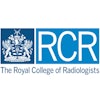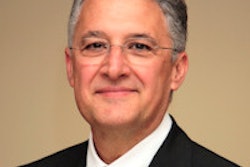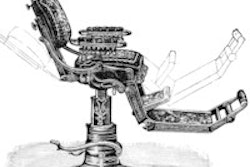
BRUSSELS - Europe's fast-evolving radiology sector needs common standards in quality, safety, training, and research, or risks seeing imaging procedures become chaotic, expensive, and dangerous, the European Society of Radiology (ESR) warned in Brussels on 4 November.
The ESR appealed to the newly installed European Commission and the recently elected European Parliament to back stricter measures for medical imaging procedures as a part of a wider effort to improve patient care and safety.
"This is a call to action," said ESR President Dr. Lorenzo Bonomo. "We need reforms to overcome differences across EU member states in quality of care and patient safety in radiology."
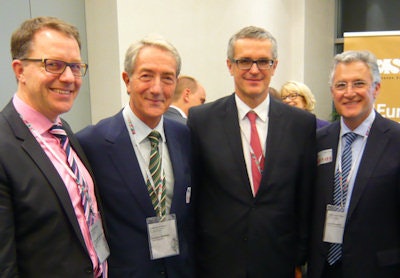 Left to right: Dr. Hans-Ulrich Kauczor, Chair of the ESR Research Committee; ESR President Dr. Lorenzo Bonomo; Andrzej Rys, director for health systems and products at the European Commission; and ESR First Vice President Dr. Luis Donoso.
Left to right: Dr. Hans-Ulrich Kauczor, Chair of the ESR Research Committee; ESR President Dr. Lorenzo Bonomo; Andrzej Rys, director for health systems and products at the European Commission; and ESR First Vice President Dr. Luis Donoso.Bonomo, who also heads the department of radiological sciences and bioimaging at Rome's Catholic University Hospital, said the radiology standards should include quality and safety indicators, as well as specific criteria for imaging procedures.
"More targeted and more efficient use of medical imaging techniques will reduce unnecessary exposure to radiation, and also improve health outcomes through better diagnosis and more effective treatment," he told event attendees. "Common indicators and parameters should be developed at the European level."
Elisabeth Morin-Chartier, a French Member of the European Parliament (MEP) and long-time supporter of ESR activities, said she would use her influence to support the proposals and speed any legislative measures through the EU system. Morin-Chartier, a leading member of the Parliament's center-right European People's Party (EPP) political group, stood alongside fellow French MEP Natalie Griesbeck from the liberal Alliance for Liberals and Democrats for Europe (ALDE) group and Italian Patrizia Toia from the left of center Socialists & Democrats (S&D) group.
"With our three groups, you have a very strong majority, and this can move national governments," Morin-Chartier said, although she declined to comment on the specifics of the ESR wish list.
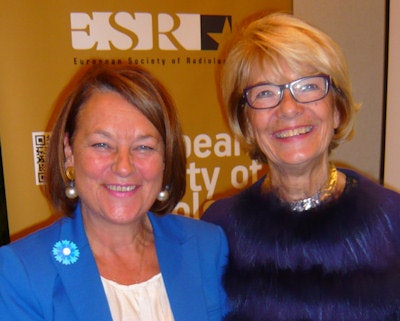 French MEPs Natalie Griesbeck and Elisabeth Morin-Chartier.
French MEPs Natalie Griesbeck and Elisabeth Morin-Chartier.The ESR event took place the day after the European Commission commenced office for a new, five-year term. Andrzej Rys, the Commission's director for Health Systems and Products, backed the principles of the ESR's appeal, but also refused to be drawn into saying what might reasonably be expected in terms of new legislation.
Former ESR President Dr. Guy Frija warned there were wide gaps across European countries in the radiology sector, from the number of radiologists per person and annual income of trainee radiologists, to CT scanners per 1,000 inhabitants and exams per person.
"For example, the mean dose for chest/thorax is about 20 times more in Germany than in the U.K.," he said.
Dr. Hans-Ulrich Kauczor, who is Chair of the ESR Research Committee and head of the radiology and diagnostic department at the University Hospital in Heidelberg, Germany, appealed for education and training for radiologists, saying there needs to be harmonization of basic standards across Europe. He called on the EU institutions to back the ESR's European Training Curriculum for Radiology and the European Diploma in Radiology, and said there should be mandatory continuous medical education and professional development throughout the EU.
"The principle of free movement of professionals in the EU has to be balanced with qualifications," Kauczor said.
Kauczor also called for European biobanks to be set up: a structured repository for imaging data to simplify access to personalized medicine, clinical trials, and drug development, as well as generic imaging biomarkers.
"European biobanks in medical imaging would improve interoperability, standardization, and data management, and ensure a harmonized approach to quality assurance of data," Kauczor said.
ESR First Vice President Dr. Luis Donoso noted a more systematized use of radiology would reduce the 10% to 30% of unneeded radiology procedures that are performed every year.
"More targeted and more efficient use of medical imaging techniques will not only reduce unnecessary exposure to radiation, and thereby help prevent harmful effects, but will also improve health outcomes through better diagnosis and more effective treatment," said Donoso, who is also the director of the diagnostic imaging department at Barcelona University Hospital.
Erik Briers, a co-founder of the European Prostate Cancer Coalition (EuropaUomo), agreed that standards were needed, not least to ensure patients remained informed.
"We patients sometimes ask for unnecessary procedures. For example, we sometimes demand an MRI when it is not needed," he said. "We need professionals to communicate. Radiologists don't live in black boxes: They are there and they should be available to explain what is happening."



